Because abdominal breathing appears to be very simple, it is often overlooked during the practice of yoga, yet it is important part of the practice. Unfortunately quite often even advanced practitioners of asanas can’t breathe abdominally.
Supine abdominal breathing
This is the easiest way to perform abdominal breathing, suitable for people who are working on developing body awareness.
Lie comfortably on your back. Place one hand on abdomen and the other on the chest or by the side.
First, observe the way you breathe and movements of the abdomen associated with breathing: on the inhalation the belly expands and on the exhalation the belly contracts. Let’s say that chest doesn’t move.
Learn to observe closely the movements of the abdomen. When abdominal breathing will be done consciously you may focus on exhalations. On exhalation pull the belly toward the spine and the chest. On inhalation first relax abdomen and then allow it to lift up.
Do not push the stomach out, it will cause tension.
Having mastered supine abdominal breathing start to practice it in a comfortable sitting position. You should focus on abdomen as well.
Breathing in sitting position:
Sit in a comfortable sitting position with your back straight.
Before exhalation pull the abdomen, starting from its lower part, toward the spine and up towards the ribs.
Before inhalation first relax your abdomen and allow it to expand like a balloon (without pushing it out).
Observe the movements of the abdomen on the inhalation and then actively exhale.
Supine abdominal breathing with passive and elongated exhalations is relaxing, calming, soothing and suitable to practice at night as a way to fall asleep easily.
Sitting abdominal breathing with active exhalations helps to keep the spine straight and elongated and is good preparation for kapalabhati, bhastrika and diaphragmatic breathing.

